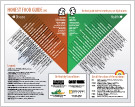
(Natural News) Researchers from the Penn State Heart and Vascular Institute made a remarkable discovery on the difference between chronic smokers and nonsmokers. They found that smoking interferes with the body’s natural ability to self-correct blood pressure. The difference was significant. Chronic smokers experience blood pressure spikes about two times greater than nonsmokers. They also suffer from a higher resting heart rate and increased arterial pressure.
Smoking jeopardizes the body’s ability to self regulate blood pressure, causing abnormal spikes in blood pressure that lead to hypertension. This finding is important because many chronic smokers look to their habit as a coping mechanism to fight stress. It turns out that smoking is putting twice the amount of stress on the body’s blood pressure, causing greater physiological stress in the long run.
Smoking alters the sympathetic nervous system, damaging blood pressure equilibrium
When a person’s blood pressure drops, the body finds equilibrium by triggering a response called muscle sympathetic nerve activity (MSNA). This natural buffering system brings blood pressure back to a normal, healthy level. A similar process is initiated when a person’s blood pressure gets too high. The body brings blood pressure down by triggering a similar system called the baroreflex.
The study found that a chronic smoker has an impaired sympathetic nervous system. When natural drops in blood pressure occur, their body releases MSNA like it should, but instead of finding equilibrium, their blood pressure spikes twofold, when compared to nonsmokers.
 |
Discover how to prevent and reverse heart disease (and other cardio related events) with this free ebook: Written by popular Natural News writer Vicki Batt, this book includes everything you need to know about preventing heart disease, reversing hypertension, and nurturing your cardiac health without medication. Learn More. |
Dr. Lawrence Sinoway, director of the Penn State Clinical and Translational Science Institute, says, “When the sympathetic nervous system fires, like with MSNA, your blood pressure rises and then a series of things happen to buffer that increase, to try to attenuate it,” Sinoway said. “We think that in smokers, that buffering — the baroreflex — is impaired.”
“The greater rise in blood pressure in response to MSNA may contribute to a higher resting blood pressure level in smokers without hypertension,” said Dr. Jian Cui, associate professor of medicine. “It’s possible that this higher response to MSNA could also contribute to the eventual development of hypertension.”
Past studies looked at the effects of acute smoking on the body’s MSNA response. This is the first study to examine the effects of chronic smoking on the baroreflex system of the human body. To examine the effects, the researchers recruited 18 chronic smokers and 42 non-smokers who showed no signs of hypertension. The researchers measured MSNA responses, heart rate, diastolic and systolic blood pressure, and average arterial pressure. There was no difference in systolic blood pressure between the two groups but there were significant differences in diastolic blood pressure, resting heart rate, and mean arterial pressure. The smokers, having smoked an average of 17 cigarettes a day over the past 13 years, experience higher levels of MSNA and blood pressure spikes twice as high as nonsmokers. They also had a higher resting heart rate and increased arterial pressure. The findings were recently published in the American Journal of Physiology–Regulatory, Integrative and Comparative Physiology.
“Our study reveals another mechanism by which habitual smoking may contribute to the development of hypertension,” Cui said. “Further studies are needed to examine if quitting smoking can decrease this accentuated response.”
“We’re hoping to better understand just how much cigarette smoking contributes to the development of hypertension,” Sinoway said. “Then, we can try to understand if there are things we can do to intervene and prevent chronic smokers from developing this condition.”
Check out StopSmoking.news for more on this important topic.
Sources include:
















